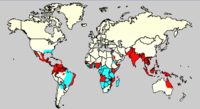
Photo from wikipedia
Dengue hemorrhagic fever (DHF) is a dengue virus infection transmitted by Aedes spp. Climate has a profound influence on mosquito breeding. Palembang has the highest rate of DHF in South… Click to show full abstract
Dengue hemorrhagic fever (DHF) is a dengue virus infection transmitted by Aedes spp. Climate has a profound influence on mosquito breeding. Palembang has the highest rate of DHF in South Sumatra. This study aimed to investigate the relationship between the components of climate factors and the incidence of DHF in Palembang. This study was cross-sectional, with an observational analytic approach. The Palembang City Health Office compiled data on DHF incidence rates from 2016 to 2020. Climatic factor data (rainfall, number of rainy days, temperature, humidity, wind speed, sun irradiance) were collected from the Climatology Station Class I Palembang - BMKG Station and Task Force that same year. The Spearman test was used to conduct the correlation test. Between 2016 and 2020, there were 3,398 DHF patients. From January to May, DHF increased. There was a significant correlation between rainfall (r = 0.320; p = 0.005), number of rainy days (r = 0.295; p = 0.020), temperature (r = 0.371; p = 0.040), and humidity (r = 0.221; p = 0.024), wind speed (r= 0.76; p = 0.492), and sunlight (r = 0.008; p = 0.865). Rainfall, the number of rainy days, and temperature were three climatic factors determining the increase in dengue incidence in Palembang.
Journal Title: Open Access Macedonian Journal of Medical Sciences
Year Published: 2021
Link to full text (if available)
Share on Social Media: Sign Up to like & get
recommendations!